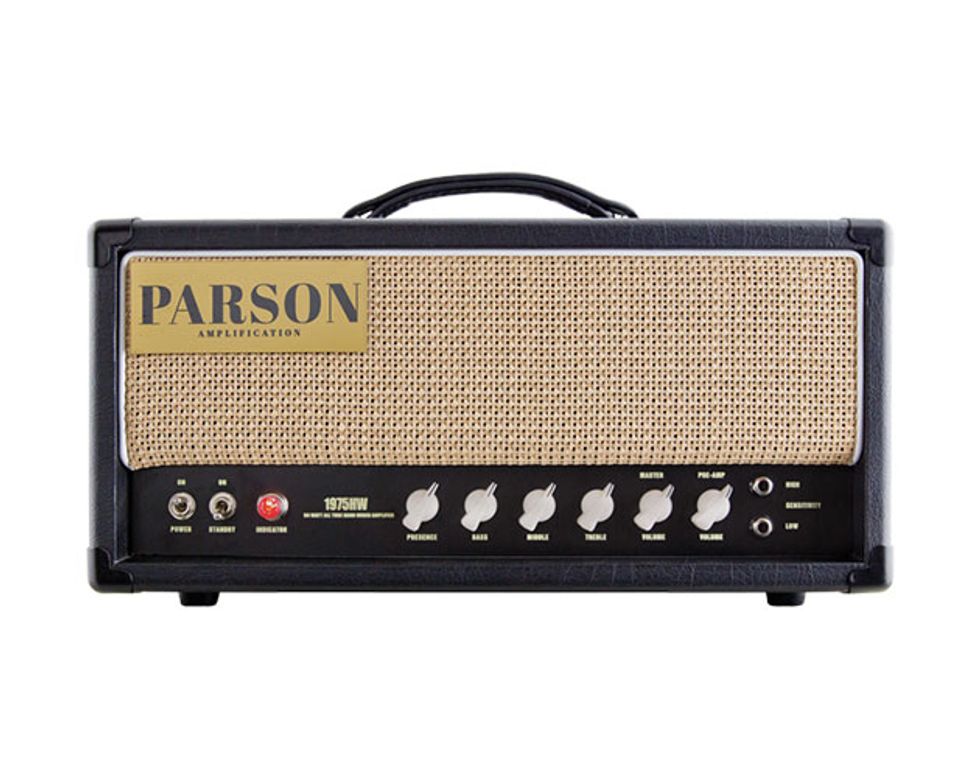Have you noticed how today’s guitar amps tend to fall into two opposing price categories? In one corner: budget-conscious, mass-produced stuff, often made in Asia using modern circuit board construction. In the other corner: handmade boutique beauties, with price tags ranging from two to four grand.
Upgrading from category A to category B can flatten your wallet like a panini press. But the situation has created a growing “middle class” of amps that aim to deliver high-end performance at prices closer to $1,000. Do these amps cut corners? Duh—how could they not? But if the builder compromises intelligently (and if you know the relevant details in advance), it’s possible to have a boutique experience at a relatively reasonable price.
In the Marshall Mode
The Parson 1975HW is a fine example of this middle-tier trend. It’s a 50-watt head modeled after Marshall’s mid-1970s JMP series amps. It’s a straightforward dual-input design with bass, mid, treble, and presence controls plus master volume. It employs two EL34 power tubes, a trio of 12AX7s in the preamp section, and a solid-state rectifier. Impedance is switchable between four, eight, and 16 ohms. Removing four screws provides access to the tubes. Remove another four, and you can lift out the entire chassis.
Several 1975HW features are remarkable for the amp’s $999 price. The head cabinet is solid wood. The tube sockets are ceramic, not plastic. All pots are chassis-mounted. Most impressively, the components are handwired on turret board. The assembly work is excellent, with immaculate soldering and neatly bundled wires. The caps and resistors are solid, standard-issue stuff. Our review model is covered in attractive black tolex. (There’s also a limited-edition run of white tolex heads.)
Cut Corners?
As expected, Parson makes compromises to deliver so much amp so inexpensively. While the cabinet is reassuringly solid, some detail work is rough. For example, the vent hole is crudely cut and un-sanded. You can’t tell unless you open the cabinet, and it doesn’t compromise the cab’s solidity. Sounds like a smart compromise to me!
Other cost-cutting measures may be more of an issue. The EL34s are inexpensive Chinese Electron Tube models. While I didn’t try swapping them out, experience suggests that higher quality tubes would provide a meaningful sonic upgrade. (You can get good replacement sets for about $100.) A bigger issue is the use of cheapo Chinese transformers. These too could be upgraded, and high-quality replacements aren’t terribly pricy. But unless you’re a qualified amp hacker, it can be an expensive job. But let’s consider the amp’s stock sound, compromises and all.
Ratings
Pros:
Ultra-dynamic. Fat crunch tones. Lovely clean tones. Quality handwiring. Low price.
Cons:
Bargain-basement tubes and transformers.
Tones:
Ease of Use:
Build/Design:
Value:
Street:
$999
Parson 1975HW
parsonamplification.com
Classic Clean and Crunch
Shortcuts notwithstanding, this is a good-sounding head capable of quality vintage-flavored tones. For the demo clip, I connected to a 2x10/1x12 THD “Mickey Mouse” cabinet, miking the 12" speaker. The gain and master volume were cranked, with all tone controls at noon.
Since amps of this sort are famed for their dynamic response, I conducted my standard SOMA (“sit on my ass”) test. I plugged in a Les Paul with vintage-style, unpotted PAFs and sat 15 feet from the amp, recording the entire clip without budging from my chair. All I did was switch pickups and fiddle with the guitar’s volume. I didn’t even touch the guitar’s tone controls.
Result? Wow. The dynamic range is superb. It was easy to veer from beefy classic-rock crunch to sparkling, articulate clean tones. Players who rely on touch dynamics are likely to love the way you can balance on the brink of distortion, leaning one way or the other via pick/finger pressure. The 1975HW’s gain is restrained compared to modern hard rock/metal amps, but there’s enough headroom to incinerate your tone via distortion pedals.
The high-gain tones are thick and harmonically satisfying. If they lack anything, it’s the “grounded” quality that fine transformers can provide. (I lack the engineering smarts to explain the phenomenon in tech terms, but my hippie-dippy visualization is that the amp is mounted on long spikes buried deep in the earth. Note fundamentals are more stable and prominent, the better to balance the glistening highs.) The amp is a bit noisy, especially on high-gain settings when plugged into the hot input, though a tube upgrade might help remedy that. The clean tones are just lovely—a sort of deeper, darker variation on the familiar Fender sparkle.
The 1975HW is seriously loud, but not so loud that you must harm yourself to summon gratifying power-amp distortion. The head sounds its absolute best with the master volume wide open, yet tones maintain heft with the control dialed back. There’s ample oomph to cut through in a loud band and fill the room at medium-sized venues. And if you play big stages, modern sound reinforcement has you covered.
The Verdict
It’s great that builders like Parson offer a middle path between mass-produced amps and breathtakingly expensive boutique models. If your love of ’70s classic rock tones is greater than your budget, the 1975HW might be a fine choice, especially if you budget an extra $100 or so for replacement tubes. Yes, the low price necessitates compromises, notably in the transformer department. Still, the 1975HW provides good, solid sounds right out of the box.








![Rig Rundown: Russian Circles’ Mike Sullivan [2025]](https://www.premierguitar.com/media-library/youtube.jpg?id=62303631&width=1245&height=700&quality=70&coordinates=0%2C0%2C0%2C0)

















